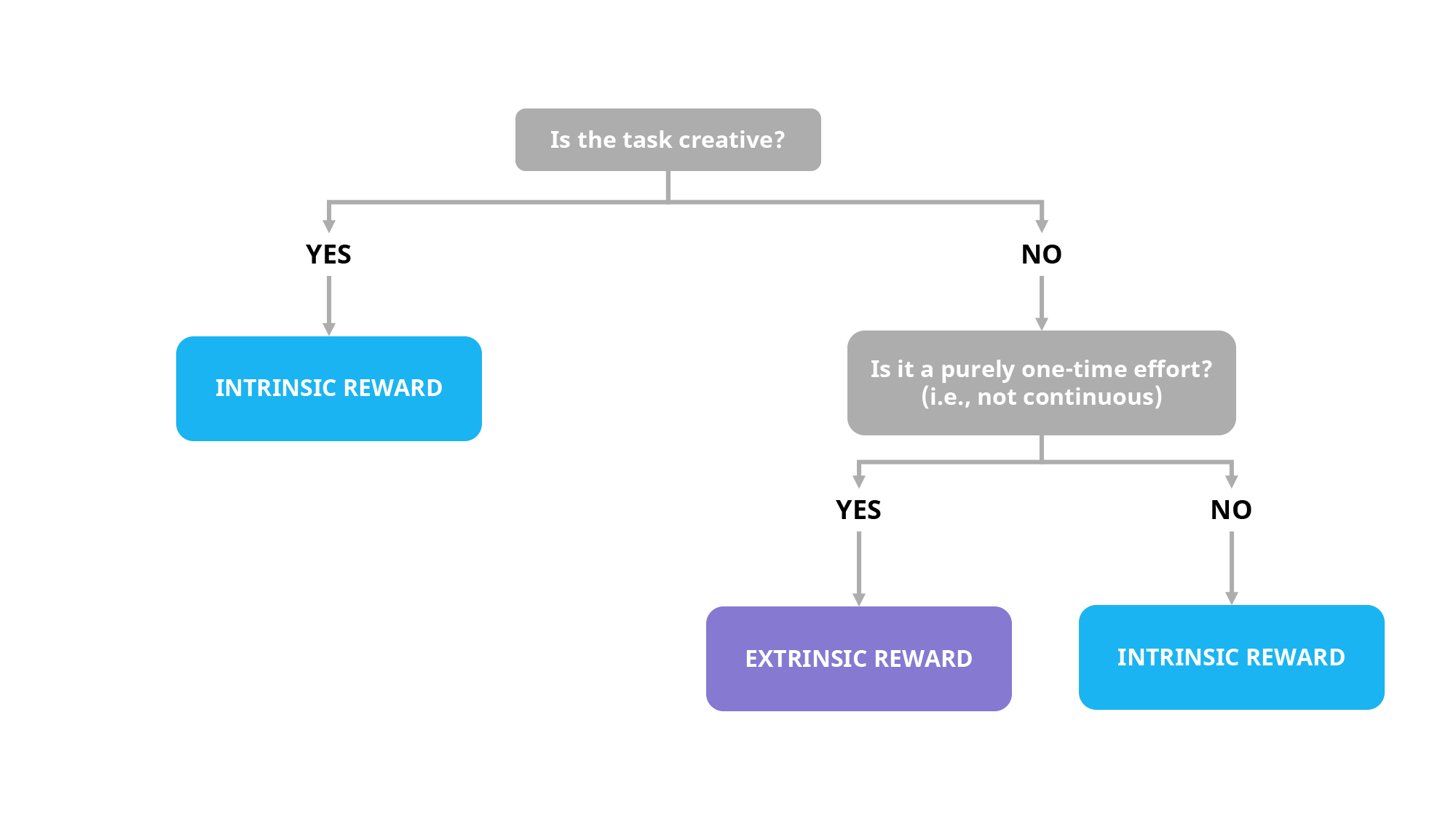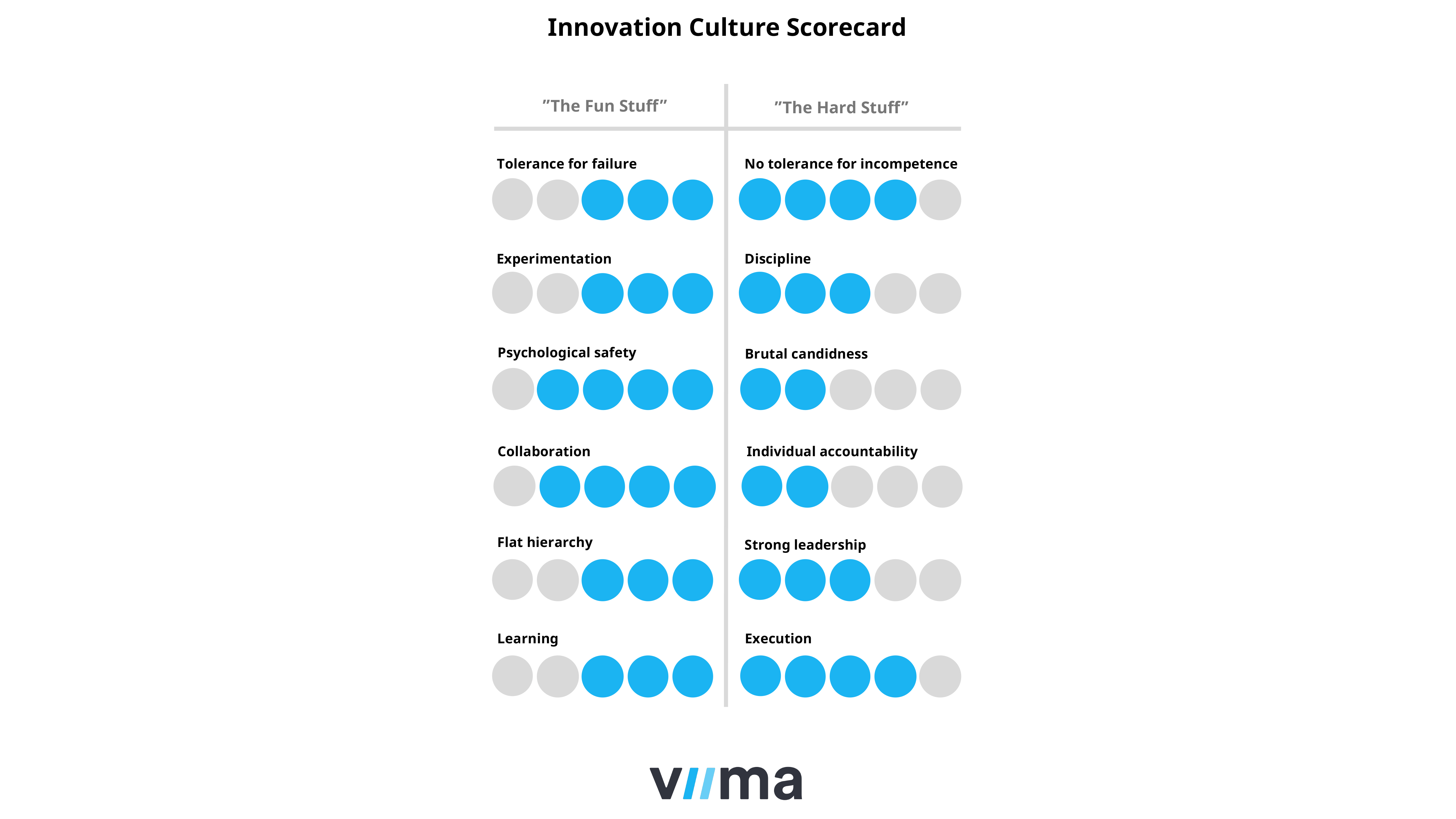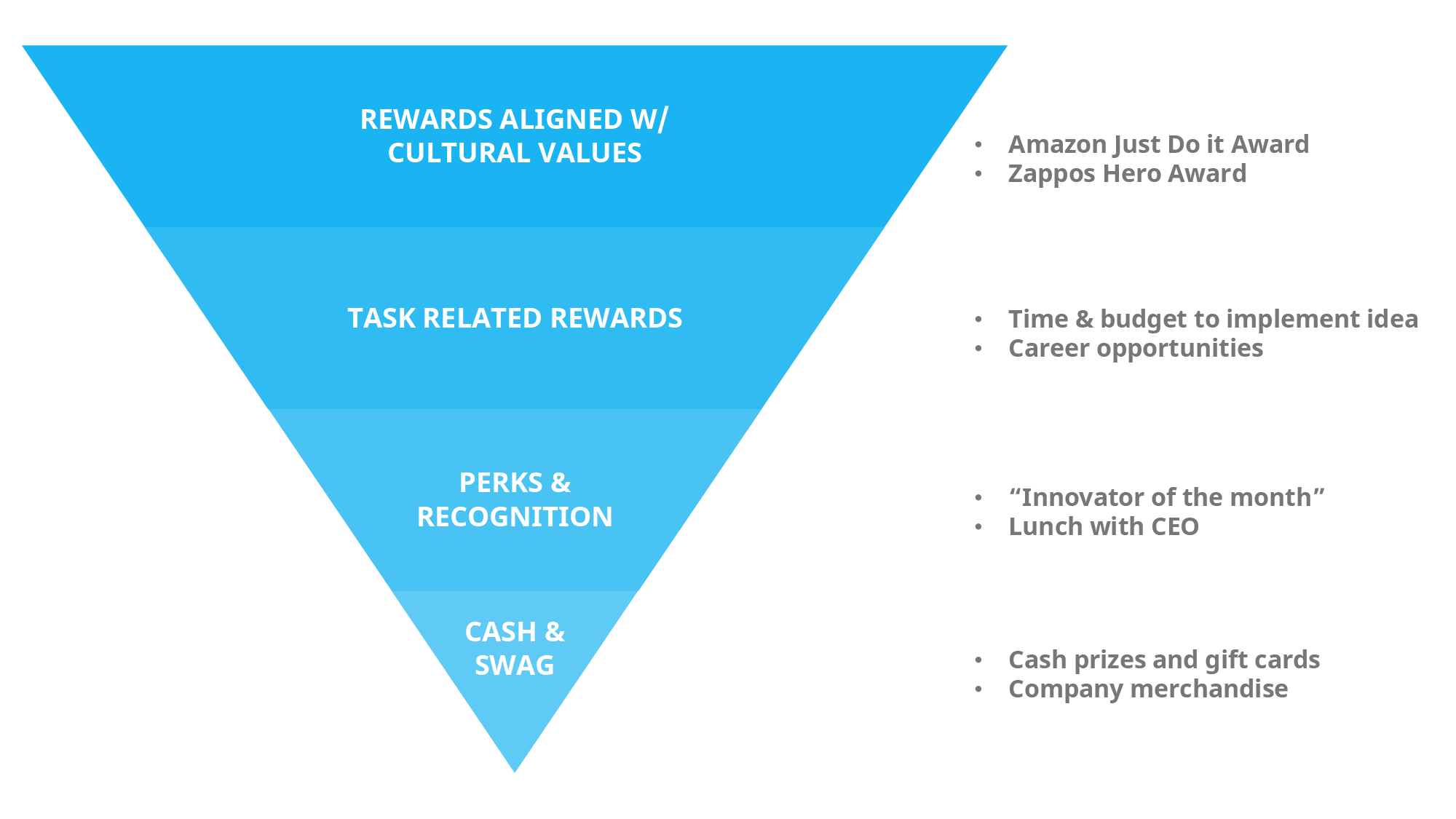How to Reward Employees in Innovation Programs
Whenever you’re building a new innovation program, or an initiative such as an idea challenge within it, one of the things you need to get right is to win employees over and get them to support the initiative and to participate in it actively.
There are of course many factors that contribute to this, such as communication, but rewarding is naturally one of these. As such, it probably doesn’t come as a surprise that it’s also a hot topic in many of our conversations with customers.
On the surface, rewarding employees for their ideas and innovations seem like a very straightforward topic. You just agree on a reward and give that out for the best idea, right?
Well, in practice, that’s usually not what you should do. Rewarding is an extremely nuanced topic with far reaching consequences not just for people’s motivation, but also for their creativity and the culture of your organization.
So, in this article, we’ll dive deeper on the intricate challenges of getting rewards right and will also provide you with advice on how you should go about it in practice.
Table of contents
What Makes Rewarding Innovation Difficult
To begin, let’s first introduce some of the key challenges in rewarding innovation. To be clear, some of these are applicable to all forms of rewarding, but some are specific to the field of innovation.
- Different people are motivated by different things. While some see a lunch with the CEO as something to die for, other people would rather have a small gift card
- …however, in our experience, top innovators aren’t usually motivated primarily by money, but by a desire to solve specific problems and make an impact
- The effect of most rewards is fleeting. They can create a short-term boost, but that usually fades quickly, and if you then decide to take the rewards away once the effect has diminished, you’ll likely have less engagement and a worse culture than before you started
- Simply rewarding the obvious things, like coming up with ideas, doesn’t necessarily lead to the desired output of better business results
- Individual rewards (which are still the norm) can often be counter-productive because innovation is ultimately a team sport
- The scientific consensus seems to be that monetary rewards don’t work for motivating creativity, and there’s evidence that they can even hurt performance in creative endeavors, such as innovation
- In some countries, employers might have to compensate employees for their inventions. However, as we're not legal advisors, we won't be discussing these legal considerations here.
We will be going into more detail on some of these later in the post, but suffice to say, the default method of handing out cash for people coming up with good ideas probably isn’t going to be the ideal solution for driving results and for creating a pro-innovation culture.
So, let’s dig a bit deeper to understand how motivation really works when it comes to creative and cognitive work.
The Theory Behind Motivation at Work
To do this, we need to take a step back and look at what motivates people in general. This is obviously an extensive topic, so we’ll just cover the key points here.
There are many well established theories on how people are motivated, such as the Two-Factor Theory, but most of them agree on a couple of key principles.
If people’s basic needs aren’t being met, those will become an overruling priority for them, and they will likely work hard to address those issues. Money and security are in this bucket.
However, once these factors reach a sufficient level, their ability to motivate dramatically diminishes. At that point, the person will become motivated by more intrinsic factors, but more on that soon.
If people’s basic needs aren’t being met, those will become an overruling priority for them, however, once these factors reach a sufficient level, their ability to motivate dramatically diminishes.
Now, pretty much every organization is likely to have employees who will be motivated by additional cash prizes, but most who already have a good job are likely to be better motivated by other factors.
Combine that with the research proving that cash rewards don’t work and can even hurt performance for cognitive and creative tasks, and the evidence against cash rewards starts to add up.
So, what should you then do?
Well, for most organizations and most people, and for cognitive tasks specifically, rewards that build intrinsic motivation are proven to work the best, as Dan Pink explains in the video above.
This is a topic we’ve previously written about in length, but it’s factors such as challenge, mastery, and purpose that are the sources of that intrinsic motivation.
Intrinsic rewards can be much more powerful, have much longer lasting effects, and even be more affordable for the organization. On the flip side, using these kinds of intrinsic rewards is a bit more complicated than using a carrot and stick approach. Regardless, they are the recommended approach for most rewards related to innovation.
Intrinsic rewards are the recommended approach form most rewards as they can be much more powerful, have much longer lasting effects, and even be more affordable for the organization.
Having said that, innovation isn’t all about just coming up with cool new ideas, there’s a lot of hard work and mundane effort required to truly make it happen. So, for some of these more mundane, one-off, parts of the process, strategic use of financial incentives can work well.
Examples of such efforts could be collecting expert evaluations for an idea or running certain types of repetitive field experiments.
Rewards Shape Culture
In addition to the question of what helps motivate an individual to contribute more, you should also consider the effect a reward will have on company culture before you choose to use it.
We’ve all heard the stories of how top management compensation being tied to short term focused metrics, such as earnings per share, has caused them to take action that isn’t exactly ideal for the long-term success of the organization and its shareholders, such as cutting innovation budgets and other long-term investments and instead using the money for dividends and share buybacks.
While the incentives of individual employees alone obviously won’t have as big of a direct impact as in the previous story, collectively they do play a huge role in shaping the culture the organization has.
So, if you’d like to create an organization that keeps delivering value with innovation, you need to create a more pro-innovation culture, and that means that your reward systems for innovation must also be aligned with those cultural values.
If you’d like to create an organization that keeps delivering value with innovation, you need to create a more pro-innovation culture, and that means that your reward systems for innovation must also be aligned with those cultural values.
We’ve talked about the characteristics of innovative cultures before in detail, but the gist of it is that an innovative culture is a strange combination of seemingly mutually exclusive characteristics. For example, if you only have a culture that is highly collaborative and encourages experimentation, you’re also going to need a culture that reinforces individual accountability and is highly disciplined.  The reason is simple: innovations require a lot of creativity, freedom, and experimentation but to realize the value from it requires a lot of hard work and a diligent and disciplined execution. Most of us aren’t naturally great at both sides, so the culture must balance that out, and that means that so should your rewards.
The reason is simple: innovations require a lot of creativity, freedom, and experimentation but to realize the value from it requires a lot of hard work and a diligent and disciplined execution. Most of us aren’t naturally great at both sides, so the culture must balance that out, and that means that so should your rewards.
Let’s take a couple of examples to illustrate how this works in practice.
As mentioned, the classic way most organizations reward employee innovation is to hand out prizes for the best ideas from idea challenges. This is likely to encourage people to submit more ideas, which is of course good, but the method also has a few implications that aren’t great for the culture and for long-term innovation results.
As we all know, most raw ideas are far from perfect, so they always need to be refined, sometimes a lot. Plus, an idea isn’t worth anything without it actually being implemented.
Thus, if you only reward the original ideators for coming up with the ideas, you’re not incentivizing the most important and value-adding parts of the process at all. What’s more, this method actively discourages people from collaborating with another because they now have a vested interest in other people’s ideas not doing great.
Most people are more than happy to share ideas and contribute if they think their idea can make a difference and they simply get recognition and fame for that contribution from their colleagues.
And, as mentioned, most people are more than happy to naturally share ideas and contribute if they think their idea can make a difference and they simply get recognition and fame for that contribution from their colleagues. However, when you introduce rewards, you risk turning these passionate innovators into mercenaries that go after individual rewards, and not results that would benefit the organization. And, again, if you were to take the rewards away once you realize they didn’t really work that well, you are likely to see people become disengaged and participation plummet. While people didn’t need these rewards to begin with, if something they had, or think they were entitled to, is being taken away from them, people will usually become angry, or at least disappointed. So, at worst, you can turn an engaged and intrinsically motivated workforce working for a common purpose into that band of mercenaries that’s only interested in themselves.
And, again, if you were to take the rewards away once you realize they didn’t really work that well, you are likely to see people become disengaged and participation plummet. While people didn’t need these rewards to begin with, if something they had, or think they were entitled to, is being taken away from them, people will usually become angry, or at least disappointed. So, at worst, you can turn an engaged and intrinsically motivated workforce working for a common purpose into that band of mercenaries that’s only interested in themselves.
The right rewards motivate individuals, but they also strive to reinforce an innovation culture.
While we’ve seen this happen a couple of times, and you should take this as a cautionary tale, usually the consequences of suboptimal rewards aren’t as dire as in the example above. Still, you should approach the topic with careful consideration.
The right rewards motivate individuals, but they also strive to create a culture of innovation. This requires a more nuanced balance between the different characteristics, but if you get it right, rewards can be a powerful force for shaping and reinforcing your culture for the better.
The Hierarchy of Innovation Rewards
So, what have we learned so far?
Well, most employees probably won’t be that motivated by simple carrots, so you should think about rewards that affect their intrinsic motivation. But the best rewards go even further than that. They reinforce the company culture and help drive the right kind of behavior, the kind that leads to more innovation, in the day-to-day.
The best rewards don’t just motivate employees, they focus on reinforcing company culture and help drive the right kind of behavior in the day-to-day.
So, when we put all of that together, we can form a simple hierarchy for the effectiveness of different kinds of rewards.  At the bottom, you have the traditional cash and swag items that most organizations unfortunately still rely on for most of their rewarding. Having said that, they're not an automatic no-no. There are some organizations, and some specific situations, where these can work relatively well.
At the bottom, you have the traditional cash and swag items that most organizations unfortunately still rely on for most of their rewarding. Having said that, they're not an automatic no-no. There are some organizations, and some specific situations, where these can work relatively well.
However, usually they only lead to short-term boosts in engagement, and often are pretty ineffective to begin with. Either way, they rarely lead to longer-term results, which is why most should look beyond just these level 1 rewards.
The next level up from that are certain perks related to the workplace. These could be simple recognitions like an “Innovator of the month” plaque, a lunch with the CEO or other executives, or a day off from the regular work to try something new. These are likely to tap into some aspects of intrinsic motivation and are usually more effective than those level 1 rewards, but don’t really do much for the company culture at large.
On the third level, the rewards are related to the results and behavior that drives results from your innovation program. Have a great idea? Well as a reward for submitting that, you can take time off from your regular, perhaps slightly boring job, and you’ll get the budget to implement that idea. These kinds of career opportunities and task related rewards will be tremendously motivating for the right kind of employees but will also take you one step closer to implementing those ideas and thus realizing the value from them.
On the final level, the rewards are often similar to those from the previous two levels but in addition are chosen so that they are truly reflective of the company values and the kind of culture you want and need to have to make innovation happen.  A great example of this is the Amazon “Just Do It Award”. It’s literally the most coveted recognition anyone can have at the company, and it’s an oversized used shoe. Just one, not even a pair.
A great example of this is the Amazon “Just Do It Award”. It’s literally the most coveted recognition anyone can have at the company, and it’s an oversized used shoe. Just one, not even a pair.
The award itself reflects the frugality that Amazon is proud of and is given to those that best exemplifies the innovative behavior they want from employees. The impact this has on the people who receive it, and the culture at large, are immense. Here’s one awardee’s story to illustrate.
Amazon’s culture can be a bit controversial, and it obviously isn’t for everyone, but that’s the point. They’ve found ways to create a culture that drives results for them, and then have memorable practices such as the Just Do It Award to reinforce that. You probably shouldn’t copy their culture and rewards as is, but it’s nevertheless a good case to learn from.
The Do’s and Don’ts
Now that we’ve covered all of that, it’s probably clear that there isn’t just a single right way to reward innovation. Some methods are likely to be more effective than others, but in the end, it all depends on what kind of a culture you have, what you value, and what your strategic goals are.
However, as there are certain practices that you should usually use, and some that you should almost always avoid, we’ve put together a simple Do’s and Don’ts list to help you bring all of that into practice.
Do’s:
- Prefer intrinsic rewards over extrinsic rewards
- Simply communicating the purpose, as well as the ability to impact the company or your own work, are often more powerful motivators than cash prizes, and so is public recognition of people as innovators – especially when coming from top management.
- Career opportunities, such as the option to pursue the implementation of your idea if it gets chosen, are a powerful motivator for participation and continued employee engagement, but also for driving practical value for the organization.
- If you use financial rewards, make sure they are only used for mundane and repetitive, non-creative tasks that just need to get done. Examples could be evaluating ideas or running field trials.
- Use rewards that are aligned with your organizational culture and values
- The Amazon Just Do It Award we covered earlier is a powerful example of this.
- Use unexpected rewards and awards
- If people are doing a task just to get a reward for completing it, they’re not forming a habit of doing that task, but of chasing that reward. Unexpected and variable rewards have been proven to be more effective at an individual level, but also do a better job of encouraging and reinforcing habits around innovation.
- Consider rewards related to the task at hand
- Based on what we’ve discussed, which one do you think is likely to be more motivating for most employees, and lead to more innovation for the organization: providing an employee with a holiday gift-card, or the opportunity to take time and resources to turn their idea into a reality?
Don’ts:
- Use individual rewards only. Innovation is a team sport.
- Teams are of course harder to reward, and team rewards might not motivate everyone as much as individual ones, but the benefits of increased collaboration are immense for culture. As such, most organizations should use both individual and team rewards.
- Only reward results. Taking initiative and learning are just as important.
- Innovation is unpredictable, so make sure to also reward people/teams that took initiative, put in a lot of effort, and did a great job, even if they ultimately failed to deliver the desired results. This shows that you understand what innovation takes and encourages the kind of behavior that is likely to lead to more value in the long run.
- Forget to involve top management in your rewarding process.
- Having the top management be engaged and actively recognize and reward innovation is a powerful driver for action. Let’s again consider Amazon’s Just Do It Award: would it have the same power if it wasn’t handed out on stage at an all-hands meeting by the CEO, but was instead given at your desk by someone from HR, and maybe posted about on the intranet?
Conclusion
Regardless of whether you’re looking to drum up interest and engagement for an idea challenge or continuous innovation process, or implement a larger innovation program or cultural transformation, rewards are an important factor to consider whenever you’re trying to encourage more innovation.
However, the impact the rewards you choose can have for the culture and employee behavior is much bigger than most people realize. As such, many leaders and managers unfortunately end up choosing overly simplistic and easy to implement rewarding schemes that drive short-term interest at the expense of longer-term results.
Hopefully this article has provided you with a more nuanced understanding of the topic, as well as some practical tips that can help you choose rewards that really drive innovation. If you have additional questions, please don’t hesitate to be in touch. We’re always glad to help.
Interested in Innovation and Leadership?
Subscribe to our blog to get the latest stories on innovation, leadership and culture straight to your inbox.





